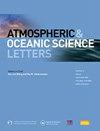北京地区一次下坡合并与对流增强的机理研究
IF 3.2
4区 地球科学
Q3 METEOROLOGY & ATMOSPHERIC SCIENCES
引用次数: 0
摘要
对2021年8月23日北京附近山区一次雷暴与邻近平原一次雷暴合并过程的数值模拟、冷池诊断和垂直运动分析表明:(1)山区雷暴向西移动缓慢,下降过程中减弱,而城区雷暴向东移动迅速且增强。最终,两个雷暴团在山脚下相遇,形成了一个线性对流系统。(2)合并前,山区雷暴星团受东部暖流阻挡,系统速度减慢,冷池减弱,与冷池流出相关的辐合上升减弱。而相邻平原上空的雷暴星团则受西侧冷平流的驱动,加速了系统的移动,强化了冷池,并在冷池外流的驱动下增强了辐合上升。雷暴团合并后,西北风和东南风的辐合以及降水导致冷空气快速积累,加强了冷池及其向上发展,其作用类似于地形特征,进一步增强了辐合和上升。(3)垂直运动特征表明,在合并前,山区雷暴群受低层负浮力主导,抑制了上升的发展,而邻近平原雷暴群受垂直压力梯度力的正扰动驱动,增加了上升。合并后,垂直压力梯度力中的正扰动在2 km以下占主导地位,随着垂直运动的增加,正浮力逐渐成为主导驱动力,进一步加强上升。分析表明,正位温扰动和邻近平原的东南或偏南风对两个趋近雷暴星团的作用相反,在合并过程中,邻近平原的雷暴星团起主导作用。摘要以往针对北京平原雷暴群和下山雷暴群合并过程的研究相对较少,利用WRF模拟数据对2021年8月23日一次此类对流活动过程分析发现:(1)雷暴群前侧风场和热力条件的差异,使得山区雷暴群移动和冷池发展受阻,而平原雷暴群则相反,最终在山脚处合并,增强后的冷池起到类似地形作用,增强辐合和上升运动;(2)合并前,山区雷暴群低层负热力浮力抑制上升运动发展,平原雷暴群低层正扰动垂直气压梯度力加速上升运动,合并后,正扰动垂直气压梯度力(2公里以下)和正热力浮力(2公里以上)共同驱动上升运动发展。本文主要对冷池和垂直运动分析, 以期为北京地区的临近预报提供一些有用的科学参考.本文章由计算机程序翻译,如有差异,请以英文原文为准。
Mechanistic study of a downhill merging and enhancement of convection in Beijing
Numerical simulation of the merging of a thunderstorm cluster from the mountain area near Beijing and a thunderstorm over the adjacent plains on 23 August 2021, along with a diagnosis and analysis of the cold pool and vertical motion, reveals the following: (1) The thunderstorm cluster in the mountain area moved slowly westward, weakening during its descent, whereas the thunderstorm cluster in the urban area moved rapidly eastward and intensified. Eventually, the two thunderstorm clusters encountered each other at the foot of the mountain and organized into a linear convective system. (2) Prior to merging, the thunderstorm cluster in the mountain area was blocked by warm advection to the east, causing the system to slow down, the cold pool to weaken, and the convergence and ascent associated with the cold pool outflow to diminish. In contrast, the thunderstorm cluster over the adjacent plains was driven by cold advection to the west, accelerating the system's movement, strengthening the cold pool, and enhancing the convergence and ascent driven by the cold pool outflow. After the thunderstorm clusters merged, the convergence of the northwesterly and southeasterly winds, as well as precipitation, led to the rapid accumulation of cold air, strengthening the cold pool and its upward development, which acted similarly to a terrain feature, further enhancing convergence and ascent. (3) The vertical motion reveals that before merging, the thunderstorm cluster in the mountain area was dominated by negative buoyancy at lower levels, which suppressed the development of ascent, whereas the thunderstorm cluster over the adjacent plains was driven by positive disturbances in the vertical pressure gradient force, which increased ascent. After the merging, the positive disturbances in the vertical pressure gradient force dominated below 2 km, and as the vertical motion increased, the positive buoyancy gradually became the dominant driver, further strengthening the ascent. The analysis suggests that the positive potential temperature disturbance and the southeasterly or southerly winds over the adjacent plains had opposing effects on the two approaching thunderstorm clusters, with the thunderstorm cluster over the adjacent plains taking the lead during the merging process.
摘要
以往针对北京平原雷暴群和下山雷暴群合并过程的研究相对较少, 利用WRF模拟数据对2021年8月23日一次此类对流活动过程分析发现: (1) 雷暴群前侧风场和热力条件的差异, 使得山区雷暴群移动和冷池发展受阻, 而平原雷暴群则相反, 最终在山脚处合并, 增强后的冷池起到类似地形作用, 增强辐合和上升运动; (2) 合并前, 山区雷暴群低层负热力浮力抑制上升运动发展, 平原雷暴群低层正扰动垂直气压梯度力加速上升运动, 合并后, 正扰动垂直气压梯度力 (2 km以下) 和正热力浮力 (2 km以上) 共同驱动上升运动发展. 本文主要对冷池和垂直运动分析, 以期为北京地区的临近预报提供一些有用的科学参考.
求助全文
通过发布文献求助,成功后即可免费获取论文全文。
去求助
来源期刊

Atmospheric and Oceanic Science Letters
METEOROLOGY & ATMOSPHERIC SCIENCES-
CiteScore
4.20
自引率
8.70%
发文量
925
审稿时长
12 weeks
 求助内容:
求助内容: 应助结果提醒方式:
应助结果提醒方式:


